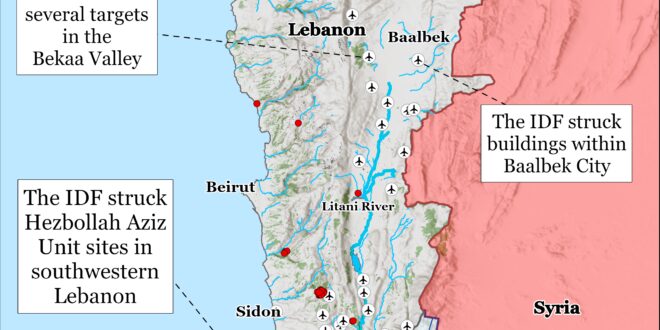The precise nature of the recent Israeli strikes into Iran has partially obscured the serious damage these strikes inflicted on critical Iranian defense and military infrastructure. These strikes could disrupt Iranian ballistic missile production and leave Iran more vulnerable to future strikes, however. The Israel Defense Forces (IDF) conducted precise and calculated strikes targeting Iranian military and defense industrial infrastructure to avoid collateral damage and casualties. The result of these precise strikes is that the damage to Iranian military infrastructure appears minimal. The Israeli strikes could disrupt Iran’s ability to manufacture advanced ballistic missiles and leave Iran more vulnerable to future strikes, however.[1] Commercially available satellite imagery published on October 28 shows that the IDF likely struck a Ghadir radar site approximately 15 kilometers north of Ahvaz, Khuzestan Province.[2] The Ghadir radar system, along with the Russian-made S-300, is an important component of the Iranian integrated air defense system.[3] The Ghadir radar system can reportedly detect ballistic missiles from a distance of 1,100 kilometers and aircraft from a distance of 600 kilometers.[4]
Commercially available satellite imagery published on October 29 separately shows damage to the Islamic Revolutionary Guards Corps (IRGC) Shahroud Missile Facility in Semnan Province, which is used to build solid-propellant ballistic missiles and launch Space Launch Vehicles (SLV) into orbit.[5] The IRGC previously launched the Soraya and Chamran-1 satellites into orbit from the Shahroud Missile Facility using the Ghaem-100 SLV in January and September 2024, respectively.[6] A missile expert told AP News on October 29 that the IRGC Shahroud Missile Facility is likely involved in “solid propellant mixing and casting operations.”[7] The same missile expert reported on October 28 that the Taksaz Industrial Innovators Engineering Company (TIECO) factory that Israel struck on October 25 in Tehran has designed and developed “mixers for high-viscosity materials” since the early 1990s.[8] The expert noted that the company could use this technology to produce solid-propellant mixers. The fact that Israel targeted mixing equipment used to make solid fuel highlights that Israel sought to degrade Iran’s ability to produce advanced ballistic missiles, such as those that Tehran has used to attack Israel directly. Unspecified Israeli sources previously told Axios that Iran will likely need at least a year to acquire new mixing equipment.[9]
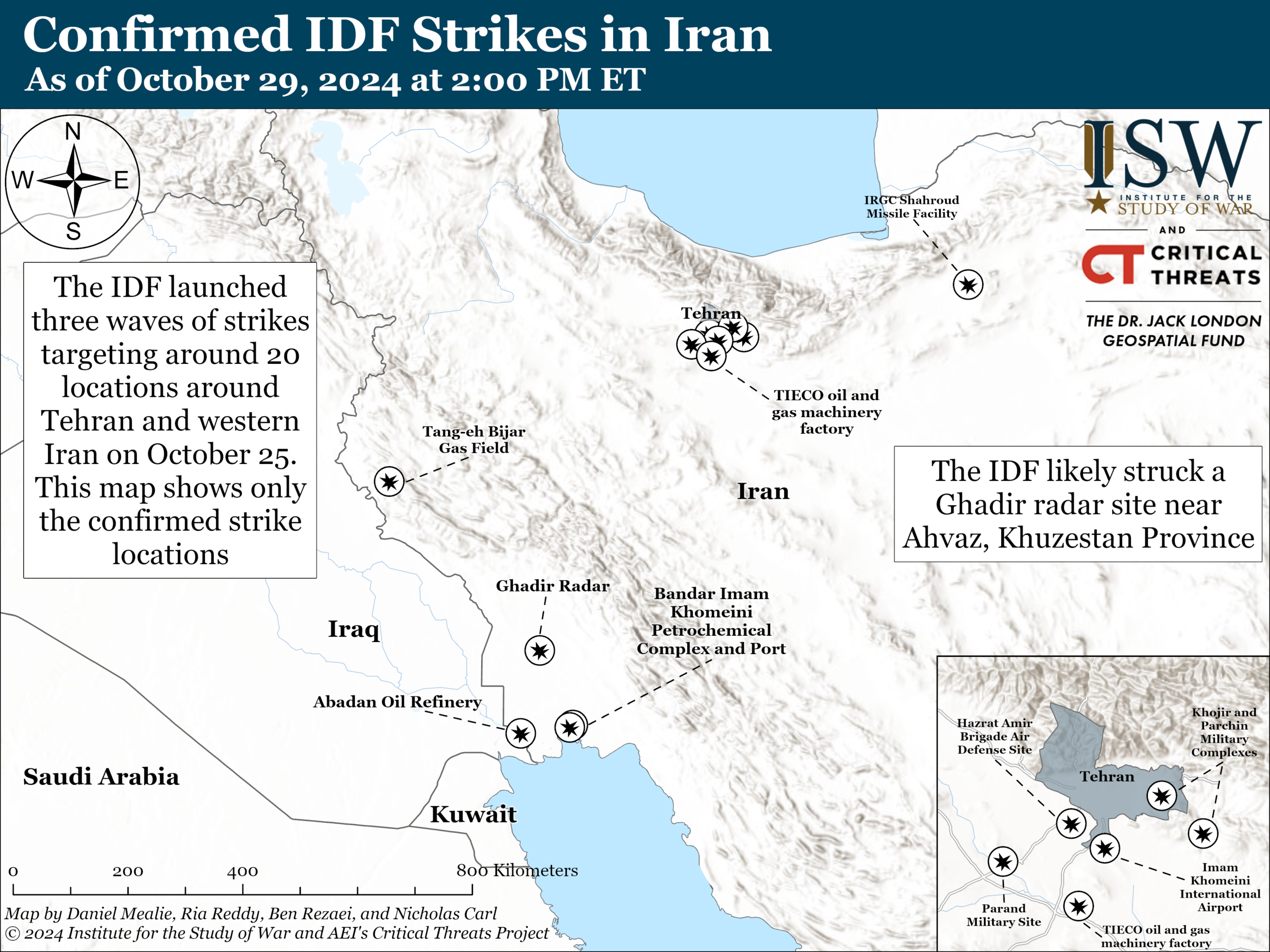
An Israeli official stated on October 26 that the IDF hit approximately 20 targets in Iran.[10] Below are the confirmed locations in Iran that the IDF hit in its October 25 retaliatory strikes:
Tehran Province
Parchin Military Complex, Tehran.[11] Parchin is one of Iran’s most expansive and sensitive defense industrial sites. Iran has used the site to develop and manufacture explosive materials and advanced munitions, including drones and missiles.[12] Iran has reportedly produced and tested chemical and nuclear weapons at the Parchin complex.[13] International Atomic Energy Agency (IAEA) inspectors found particles of man-made uranium at the Parchin site in 2015, indicating the presence of a larger quantity of uranium at one point, although Iran denied that the facility was tied to the nuclear program.[14] Former UN Weapons inspector David Albright said the buildings that the IDF hit at Parchin were used for mixing solid fuel for ballistic missiles.[15]
Khojir Military Complex, Tehran.[16] Khojir is a missile production complex tied to the Parchin facility that is involved in the production of liquid- and solid-fuel missiles for the IRGC. Reuters reported satellite imagery revealed significant expansions at the site in July 2024.[17] The Khojir site is tied to various state-owned defense companies including Shahid Hemmat Industries Group (SHIG).[18] SHIG is one of Iran’s “primary entities responsible for ballistic missile development and production,” according to the US. SHIG has been sanctioned by the US, EU, and the UN for its role in Iran’s nuclear and missile programs.[19] Commercially available satellite imagery showed that the IDF destroyed two buildings in the Khojir complex.[20]
S-300 surface-to-air missile battery, Imam Khomeini International Airport, Tehran.[21] The Russian-made S-300 air defense system at the Imam Khomeini International Airport provides air defense cover for Tehran city.[22]
S-300 surface-to-air missile battery, Hazrat Amir Brigade Air Defense Site, Elamshahr.[23] The IDF struck an S-300 site near the Hazrat Amir Brigade Air Defense Site. The Amir ol Momenin Air Defense Brigade manages the S-300 equipment at the site.[24] The brigade is part of the Artesh, Iran’s conventional military.
Parand Military Site, Tehran.[25] Unspecified Iranian and Israeli officials told the New York Times that the IDF targeted the Parand military site with drones.[26] Western media reported that the IDF hit this site, but there is no publicly available information on the purpose of this site at the time of writing.[27]
Taksaz Industrial Innovators Engineering Company (TIECO) Factory, Shams Abad.[28] See above for details.Khuzestan Province
Abadan oil refinery, Khuzestan.[29] This is Iran’s largest oil refinery located near the Persian Gulf.[30] The United States Treasury Office of Foreign Assets Control (OFAC) sanctioned the Abadan Oil Refining Company, located at the Abadan oil refinery, in 2020 for facilitating revenue for the Islamic Revolutionary Guards Corps (IRGC) Quds Force.[31]
Bandar Imam Khomeini Petrochemical Complex, Khuzestan.[32] The IDF struck Iranian defense systems at the Petrochemical Complex.[33] This complex is Iran’s largest petrochemical compound and generates ”millions of tons of petroleum-based products” for exporting purposes annually.[34]
Bandar Imam Khomeini Port, Khuzestan.[35] The IDF struck the Port adjacent to the Bandar Imam Khomeini Petrochemical Complex. This port serves as a major economic port on the Persian Gulf.
Ghadir Early Detection Radar, Ahvaz.[36] See above for details.Ilam Province
Tang-eh Bijar Gas Field, Ilam.[37] The IDF struck air defense systems at the refinery for the Tang-eh Bijar gas field.[38]Semnan Province
IRGC Shahroud Missile Facility / Shahroud Space Center, Semnan. See above for details.Israeli media reported on October 28 that Israel is planning to retaliate separately against Iran for the October 19 Lebanese Hezbollah drone attack that targeted Israeli Prime Minister Benjamin Netanyahu.[39] Israeli media reported that the IDF strikes into Iran on October 25 were only in response to the large-scale Iranian ballistic missile attack against Israel on October 1 and that Israel is preparing a separate retaliation for the Hezbollah attack that targeted Netanyahu.[40] The Israeli security cabinet reportedly convened for six and a half hours on October 27 to discuss, among other topics, the October 19 Hezbollah attack.[41] An Israeli journalist emphasized that the Israeli response to the October 19 Hezbollah attack “is not expected to be similar” to the Israeli strikes in Iran on October 25.[42]
Hezbollah’s Shura Council appointed Naim Qassem as the new Hezbollah secretary general, on October 29.[43] Qassem replaces former Secretary General Hassan Nasrallah, who Israel killed on September 27.[44] Qassem is a founding member of Hezbollah and has been Hezbollah’s deputy secretary general since 1991.[45] Qassem focused on political issues while serving as deputy secretary general but he has assumed a more public-facing role since Nasrallah’s death.[46] Emirati media cited an Iranian source that said that Qassem fled Lebanon on October 5 aboard the Iranian foreign minister’s plane.[47] CTP-ISW is unable to independently confirm this report. The IDF killed Nasrallah’s presumed successor Hashem Safi ed Din on October 3, likely increasing the urgency for Hezbollah and Iran to move possible leaders out of Beirut.[48] The IDF has killed the majority of Hezbollah’s senior leadership by airstrike in Beirut. Qassem is a less popular and charismatic figure than Nasrallah but will likely have success in consolidating internal support to effectively lead the movement due to his long history with the movement.
Qassem’s October 15 speech offers insights into his strategy and vision of the war.[49] Qassem viewed Hezbollah’s war with Israel as existential and said that he believes the United States and Israel seek to shape Lebanon and “run it as they wish.”[50] He also dismissed Israeli claims that Hezbollah fighters are failing to defend against Israeli ground operations in southern Lebanon.[51] Qassem indicated that Israel’s ground and air operations have not changed Hezbollah’s willingness to negotiate a political settlement or ceasefire.[52] Qassem announced a new war “phase” designed to inflict high casualties on Israel. Hezbollah has likely implemented this phase, given that it conducted a record number of attacks for the war on October 25 and struck Israeli Prime Minister Benjamin Netanyahu’s home with a drone.[53] Qassem’s statements suggest that Hezbollah will not temper its goals or military operations under his leadership.
Israeli forces have advanced at least four kilometers into southern Lebanon towards the southeastern outskirts of Khiam.[54] This is the IDF’s deepest advance into Lebanon since ground operations began on October 1. Lebanese media reported that numerous IDF tanks entered Lebanon from near Metula on October 28 and advanced north to Tal al Hamamis and into Khiam’s southeastern outskirts.[55] Geolocated footage also showed an IDF vehicle driving north on the southeastern outskirts of al Khiam on October 29.[56] Lebanese state media reported that Israeli tanks advanced at least six kilometers into Khiam’s outskirts, although CTP-ISW cannot verify this claim.[57] Lebanese sources reported that IDF airstrikes, artillery shelling, and illumination rounds targeted the Khiam area during the IDF’s advance, which would have supported Israeli ground forces’ movements.[58] The IDF 98th and 91st divisions have operated south of Khiam in recent weeks.[59]
Khiam’s terrain provides an expansive view of northern Israel and would enable Hezbollah artillery observers to support indirect fire attacks into Israel. Observers can directly view a large swath of territory in the Galilee panhandle, Shebaa Farms, and Golan Heights from Khiam, including several IDF Northern Command bases. Positions in Khiam and on nearby hills could enable Hezbollah artillery observers to direct rocket and mortar attacks into northern Israel. The IDF has likely already seized terrain on Tal al Hamamis, located between Metula and Khiam, which would prevent Hezbollah from using the elevated terrain to conduct direct fire or support indirect fire attacks into the Upper Galilee from there.[60] The IDF began ground operations to eliminate Hezbollah’s ability to conduct indirect fire attacks into northern Israel from positions in Lebanon. The IDF has previously seized hills in southern Lebanon that would enable Hezbollah to direct attacks targeting Israel to this end, including in Maroun al Ras, Mays al Jabal, and Odaisseh.[61]
Hezbollah and Lebanese media reported a high volume of engagements between Hezbollah fighters and Israeli armor advancing towards Khiam.[62] Hezbollah fighters reportedly fired anti-tank guided missiles, rockets, and mortars at Israeli forces advancing in numerous locations, including south, southeast, and southwest of Khiam.[63] A Hezbollah-affiliated correspondent also reported that Hezbollah fighters engaged Israeli forces in Khiam’s southern neighborhoods.[64]
Israel and Lebanon are reportedly “in advanced stages” of reaching a ceasefire agreement.[65] Senior Israeli officials speaking to Ynet said on October 29 that the deal would begin with a 60-day “acclimation period” ceasefire during which mediators would consider a “new mechanism” to supervise southern Lebanon and prevent Hezbollah from rebuilding military infrastructure there.[66] The IDF would withdraw most of its forces from southern Lebanon and only remain in certain areas where it still needs to destroy Hezbollah infrastructure.[67] This deal appears to attempt to more successfully implement UNSCR 1701, which prohibits Lebanese Hezbollah military activity in southern Lebanon.[68] To enforce UNSCR 1701 the Lebanese Armed Forces (LAF) would deploy thousands of additional soldiers to southern Lebanon.[69] UNIFIL forces would be increased and bolstered by additional French, German, and British troops.[70] The plan proposes that Israel retains the right to take “prolonged action” in Lebanon to remove Hezbollah threats that Lebanese and international forces fail to address.[71] Lebanese Prime Minister Najib Mikati announced on October 24 that his government plans to recruit more LAF troops and possibly deploy 8,000 soldiers to southern Lebanon.[72] The agreement would finally include a ban on military imports to Lebanon to prevent Hezbollah from rearming.[73] Israeli Prime Minister Benjamin Netanyahu’s Office has previously insisted that the Israel Defense Forces (IDF) be allowed to engage in “active enforcement” near the Israel-Lebanon border and to maintain “freedom of operation” in Lebanese airspace.[74] Israeli media did not include Israeli access to Lebanese airspace in their most recent reporting about the proposal.[75]
Israeli Prime Minister Benjamin Netanyahu held a security meeting with senior military officials on October 29 to discuss the possible ceasefire terms.[76] Hezbollah has not commented on the negotiations and has not indicated if it would accept the deal. Hezbollah had previously made stopping its operations against Israeli forces contingent on halting Israeli operations in the Gaza Strip.[77] Hezbollah’s new Secretary General Naim Qassem indicated on October 8 that the group may be open to a ceasefire that is not linked to the Gaza Strip.[78] A successful implementation of the above ceasefire framework that pushes Hezbollah fighters and infrastructure north of the Litani River would reduce the threat of a Hezbollah October 7–7-style offensive into northern Israel. The terms would likely be insufficient to stop rocket fire into Israel due to the range of Hezbollah’s rocket and missile arsenal, however.[79]
Key Takeaways:
- Israeli Strike on Iran: The precise nature of the recent Israeli strikes into Iran has partially obscured the serious damage these strikes inflicted on critical Iranian defense and military infrastructure. These strikes could disrupt Iranian ballistic missile production and leave Iran more vulnerable to future strikes, however.
- Israeli Retaliation Against Iran and Hezbollah: Israeli media reported on October 28 that Israel is planning to retaliate separately against Iran for the October 19 Lebanese Hezbollah drone attack that targeted Israeli Prime Minister Benjamin Netanyahu.
- Hezbollah’s New Leader: Hezbollah’s Shura Council appointed Naim Qassem as the new Hezbollah secretary general, on October 29. Qassem’s October 15 speech offers insights into his strategy and vision of the war. Qassem viewed Hezbollah’s war with Israel as existential and said that he believes the United States and Israel seek to shape Lebanon and “run it as they wish.”
- Israeli Ground Operations in Lebanon: Israeli forces have advanced at least four kilometers into southern Lebanon towards the southeastern outskirts of Khiam. Khiam’s terrain provides an expansive view of northern Israel and would enable Hezbollah artillery observers to support indirect fire attacks into Israel.
- Lebanon Ceasefire: Israel and Lebanon are reportedly “in advanced stages” of reaching a ceasefire agreement. This deal appears to attempt to more successfully implement UNSCR 1701, which prohibits Lebanese Hezbollah military activity in southern Lebanon.
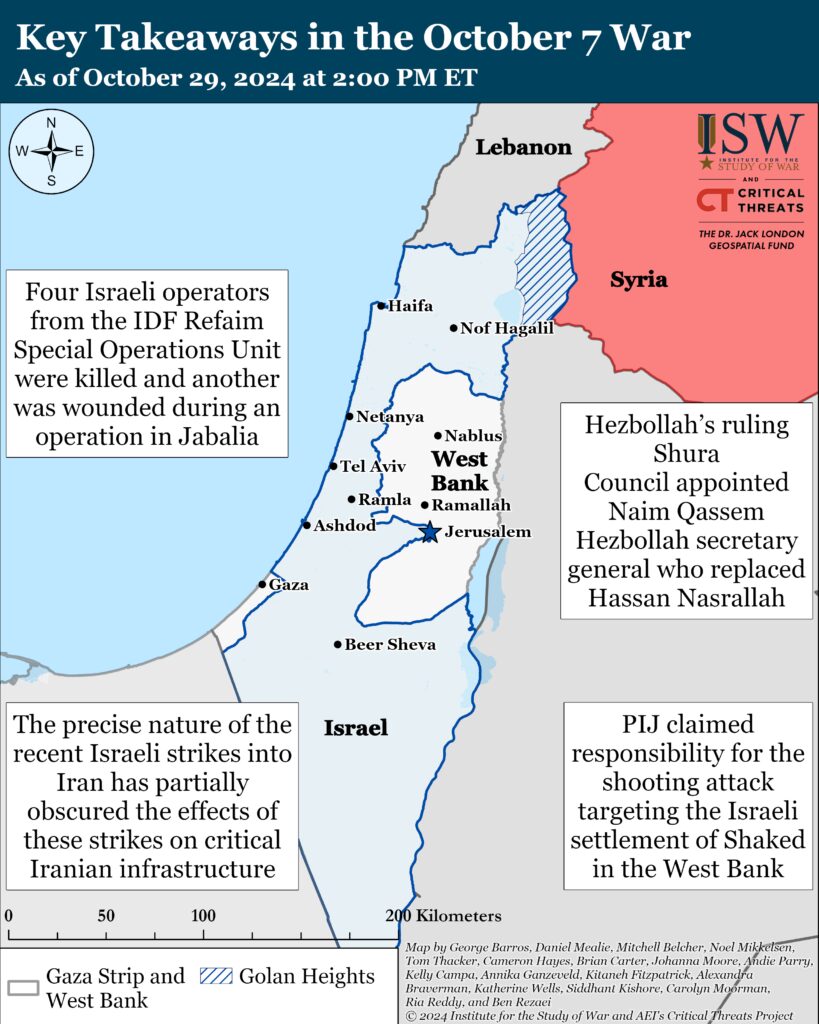
Gaza Strip
Axis of Resistance objectives:
Erode the will of the Israeli political establishment and public to sustain clearing operations in the Gaza Strip
Reestablish Hamas as the governing authority in the Gaza StripThe IDF 162nd Division continued clearing operations in Jabalia in the northern Gaza Strip on October 29. Israeli forces killed dozens of Palestinian fighters in airstrikes and ground engagements.[80] Israeli forces located and destroyed stockpiles of weapons and military equipment including rifles, anti-tank munitions, and radios.[81]
The IDF announced that four Israeli soldiers from the IDF Refaim special operations unit were killed and another was wounded during an operation in Jabalia.[82] The IDF did not elaborate on how the soldiers were killed. The Refaim Unit has been conducting targeted raids in Jabalia refugee camp over the past two weeks.[83]
Palestinian Islamic Jihad (PIJ) and the al Aqsa Martyrs’ Brigades—the self-proclaimed militant wing of Fatah—each claimed one mortar attack targeting Israeli forces along the IDF’s supply route on the Netzarim Corridor.[84]
The IDF 252nd Division continued targeted raids in the central Gaza Strip on October 29.[85] Israeli forces engaged Hamas fighters who attempted to plant an improvised explosive device (IED) near Israeli forces. The IDF 252nd Division has operated around Nuseirat and Bureij refugee camps in the central Gaza Strip since October 17.[86]
The 933rd Infantry Brigade (143rd Division) directed airstrikes targeting Palestinian fighters in Rafah on October 29.[87] The al Aqsa Martyrs’ Brigades mortared Israeli forces operating in al Janina neighborhood, eastern Rafah.[88] The al Aqsa Martyrs’ Brigades and the Abdul al Qadir al Husseini Brigades—a splinter group of the al Aqsa Martyrs‘ Brigades—claimed a combined mortar attack targeting Israeli forces east of Rafah City, in al Janina neighborhood.[89] The National Resistance Brigades claimed a separate mortar attack targeting Israeli forces present near the Salah al Din Gate on the Gaza-Egypt border.[90]
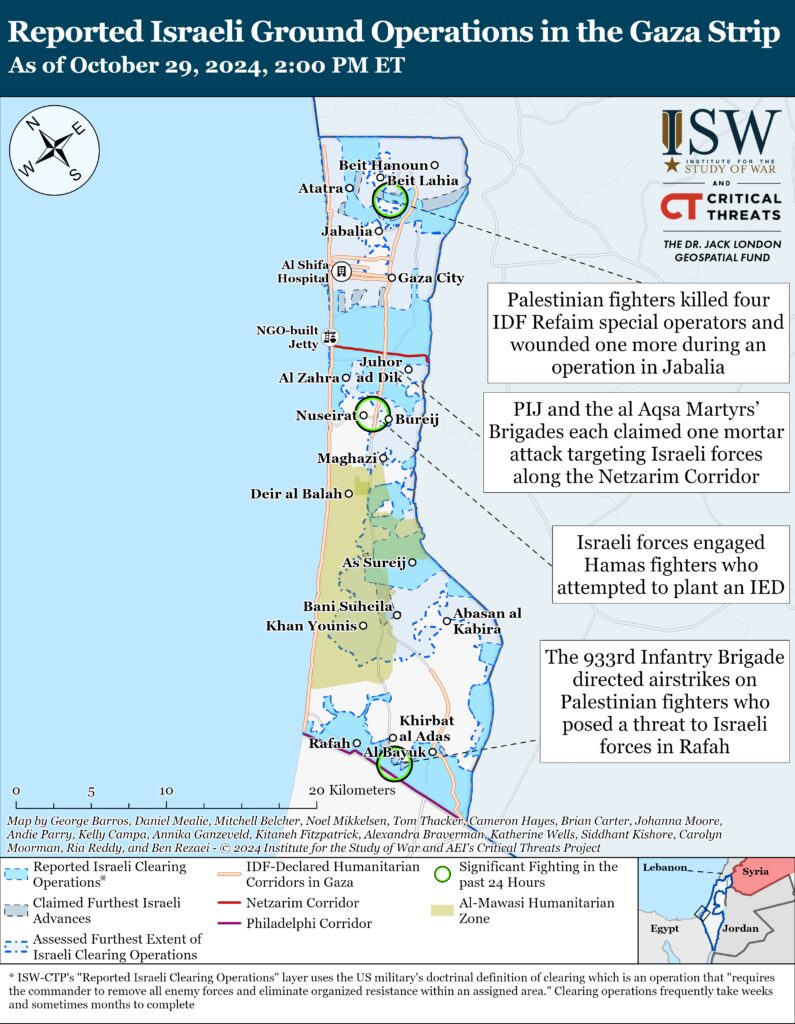
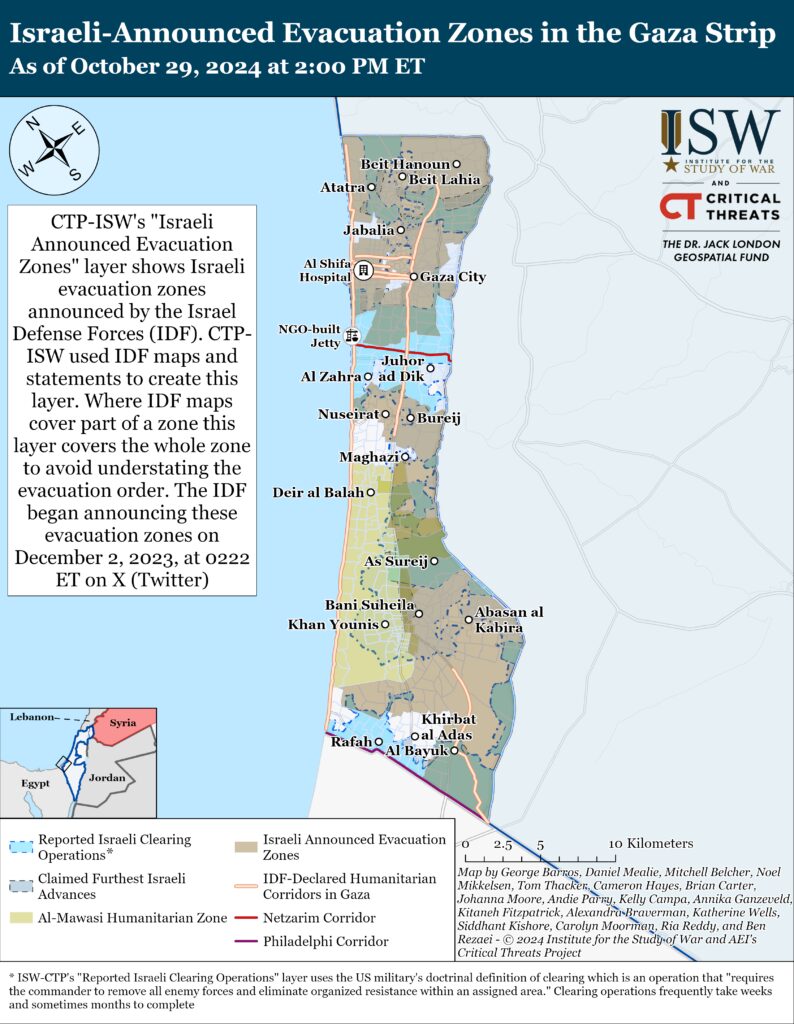
Qatari Foreign Ministry spokesperson Majed Mohammed al Ansari claimed on October 29 that ceasefire-hostage negotiations have made progress.[91] CIA Director Bill Burns, Mossad Director David Barnea, and Qatari Prime Minister Qatar Mohammed bin Abdulrahman al Thani reportedly discussed a 28-day pause in fighting in the Gaza Strip during which Hamas will release eight Israeli hostages in exchange for Israel releasing ”dozens” of Palestinian prisoners, according to three unspecified Israeli officials cited by Axios.[92]
West Bank
Axis of Resistance objectives:
Establish the West Bank as a viable front against IsraelIsraeli settlers fired small arms targeting Palestinian Authority (PA) security forces near an Israeli settlement of Havat Gilad in the West Bank on October 29.[93] The Israeli Army Radio reported that the shooting incident injured two PA security officials.[94] The IDF condemned the shooting incident and started an investigation into it.
The IDF reported on October 29 that it has detained approximately 260 wanted persons across the West Bank in the past month in order to thwart “terrorism” in the West Bank.[95] The IDF also destroyed “dozens” of improvised explosive devices (IEDs), confiscated approximately 50 firearms and “hundreds of thousands” of Israeli shekels used in “terrorist funds,” and seized “dozens” of illegal vehicles in the West Bank in the past month.[96]
Palestinian Islamic Jihad (PIJ) claimed responsibility for the shooting attack targeting the Israeli settlement of Shaked in the West Bank on October 28.[97] The fighter approached the settlement in a vehicle and opened fire at the settlement before fleeing to a nearby Palestinian village on foot.[98] The IDF reported no casualties and launched a search operation in the area to locate the fighter.[99]
Israeli forces have engaged Palestinian fighters in at least one location in the West Bank since CTP-ISW’s last data cut-off on October 28.[100] The al Aqsa Martyrs’ Brigades fired small arms targeting Israeli forces operating in al Ain refugee camp, Nablus.[101]
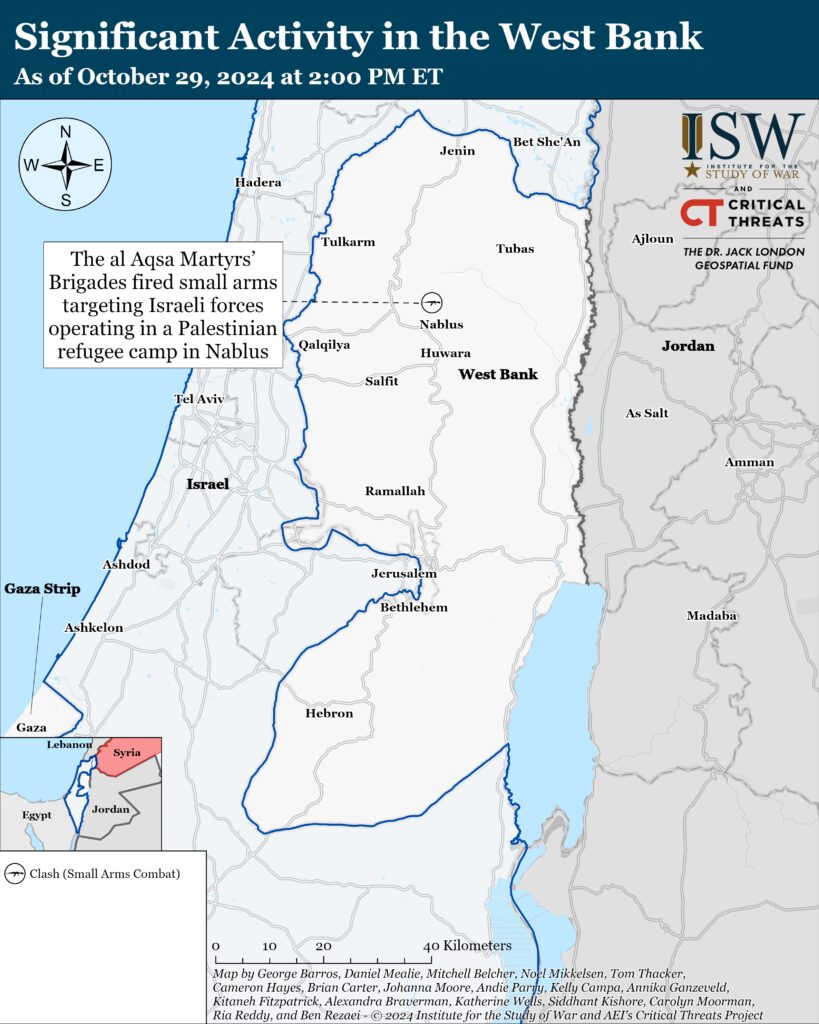
Northern Israel and Lebanon
The IDF 91st Division continued operations to secure the village of Kfar Kila.[102] The IDF allowed journalists to visit Kfar Kila, west of Metula, on October 28.[103] Securing a village would require Israeli forces to prevent Hezbollah from conducting direct or observed indirect fire attacks targeting the village. Geolocated footage shows Israeli forces operating in Kfar Kila immediately along the Israel-Lebanon border.[104] Israeli forces appear to have at least partially secured Kfar Kila, given the presence of Israeli journalists. Journalists entered Kfar Kila in armored vehicles near Fatima’s Gate. Hezbollah claimed that it previously rocketed Fatima’s Gate on October 28 and mortared Israeli personnel on Tal al Nahas on the outskirts of Kfar Kila on October 29. It is unclear if a Hezbollah observer directed this fire, but accurate and effective indirect fire would indicate that Kfar Kila is only partially secure at most.[105] IDF bulldozers are currently attempting to “destroy all the Hezbollah infrastructure so [Hezbollah fighters] don’t return,” according to the IDF 769th Territorial Brigade commander.[106] The IDF 1st Infantry (36th Division) and 35th Paratroopers (98th Division) brigades are currently operating in Kfar Kila to clear rigged buildings, kill cells of fighters, and locate Hezbollah fighters hiding in the village.[107] The IDF reported that the 91st Division located underground Hezbollah infrastructure and killed Hezbollah fighters in the past day.[108]
The journalists’ visit follows the IDF’s announcement on October 28 that Israeli forces had “destroyed” Hezbollah’s ability to conduct a ground infiltration of Israel from Kfar Kila.[109] An IDF commander said that Radwan SOF had planned to initiate Hezbollah’s long-planned ground infiltration into Israel from Kfar Kila by capturing adjacent Metula.[110]
Hezbollah claimed it fired a drone targeting IDF personnel east of Aitaroun on October 28.[111] Israeli forces have operated in and near Aitaroun since October 23.[112]
The IDF 36th Division detained Hezbollah’s commander responsible for Aita al Shaab two weeks ago.[113] The IDF announced on October 29 that the IDF 1st Infantry Brigade identified several Hezbollah fighters inside an underground compound during operations in Aita al Shaab about two weeks ago.[114] Hezbollah’s commander for the Aita al Shaab region, Hassan Akil Jawad, was among the fighters in the compound.[115] Israeli forces detained and interrogated the fighters and brought them to Israel for further interrogation.[116] The IDF published a map of Hezbollah infrastructure in Aita al Shaab identified by the detained fighters.[117] Israeli Army Radio reported that the IDF’s release of information about Jawad’s arrest and the map of sites discovered from the intelligence gathered from him and other detainees is unprecedented.[118] Israeli Army Radio reported that the IDF is attempting to degrade Hezbollah fighters’ morale and encourage internal criticism amongst Hezbollah’s rank-and-file.[119]
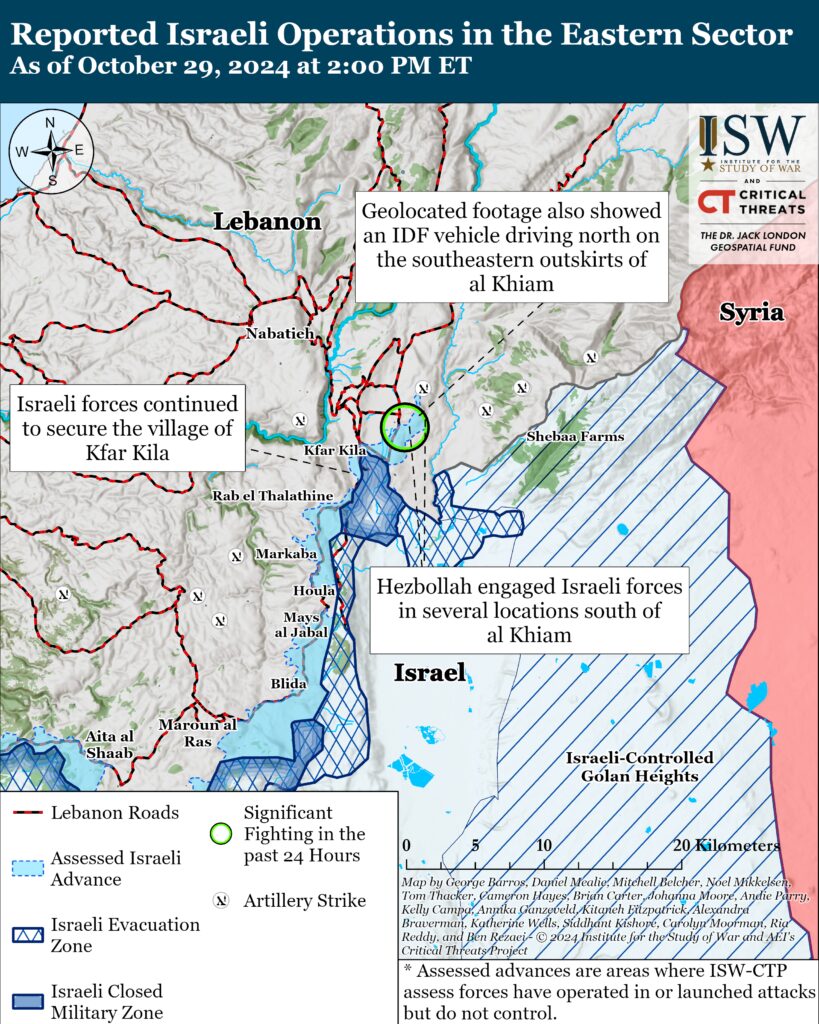
The IDF 146th Division continued clearing operations in southwestern Lebanon on October 29. Commercially available satellite imagery captured on October 29 showed flattened terrain and destroyed buildings on the Naqoura-Rmeish Road in southern Zalloutiyeh and vehicle tracks southwest of Oum Touteh in southwest Lebanon, suggesting that Israeli forces operated west of Yarine. The 146th Division targeted Hezbollah military buildings and infrastructure used to plan attacks against Israel.[120] The IDF 2nd Infantry Brigade (Res.) and Yahalom combat engineers located and demolished a Hezbollah headquarters located eight meters underground.[121] Israeli forces also located a separate underground complex that Hezbollah built several years ago underneath a Lebanese village.[122] The complex contained half a ton of explosives.[123] Hezbollah-affiliated media reported that Hezbollah conducted an unspecified attack targeting an IDF infantry unit in Dahyra.[124]
The IDF said Hezbollah fired rockets that impacted UNIFIL’s headquarters in Naqoura, southern Lebanon, on October 29.[125] The rockets set a vehicle workshop at the headquarters on fire.[126] UNIFIL said that Hezbollah or an affiliated group likely fired the rockets, which were fired from north of UNIFIL’s headquarters.[127] The IDF said that Hezbollah launched the rockets from the Hallousiyyeh al Fawqa area.[128] Eight Austrian peacekeepers were slightly injured in the attack.[129]
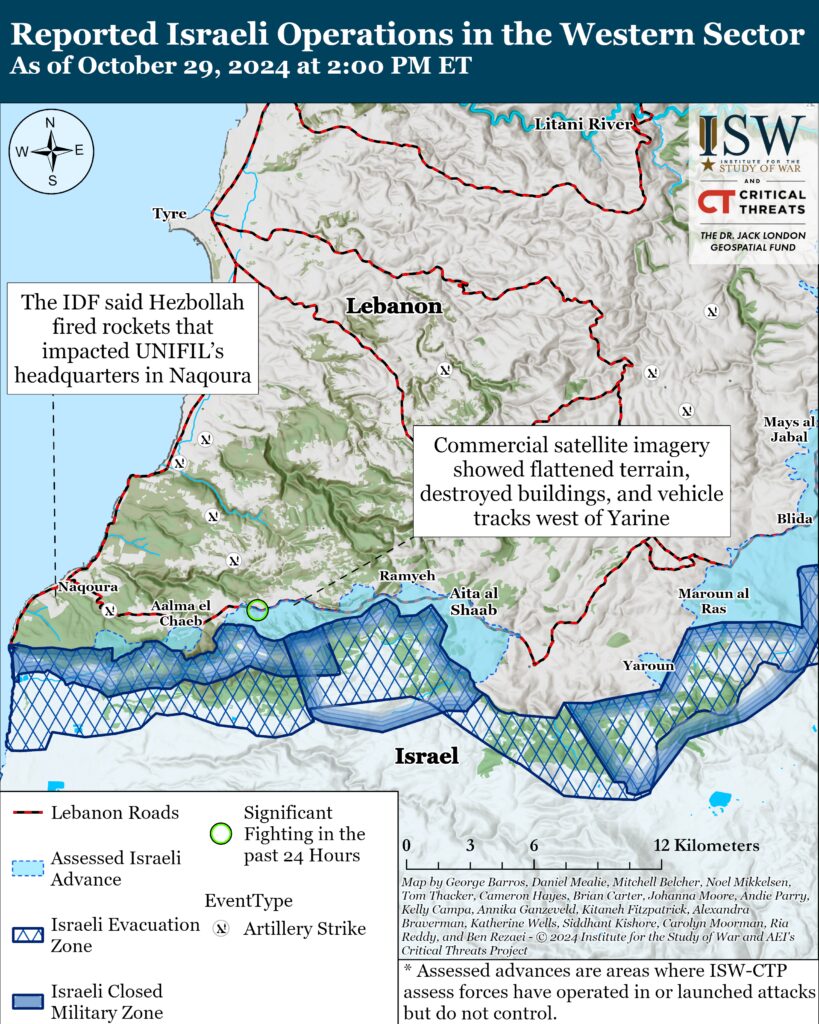
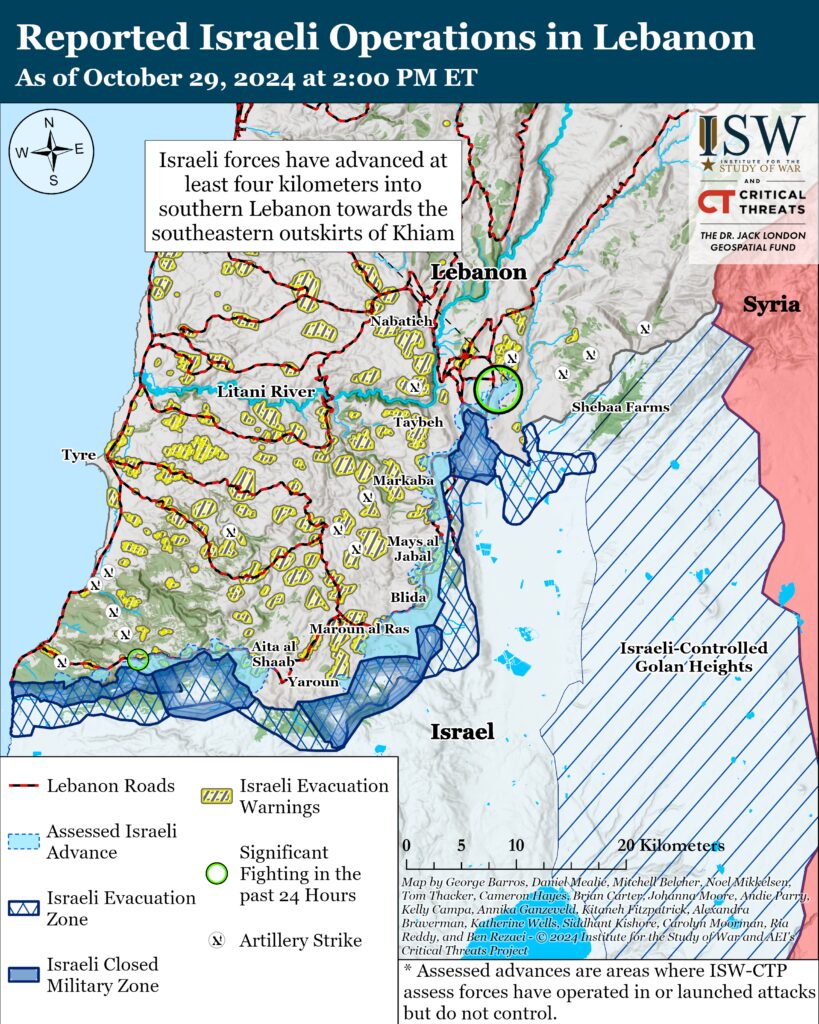
The IDF continued its air campaign to degrade Hezbollah’s capabilities and infrastructure on October 29. The IDF Air Force struck over 110 Hezbollah targets in the past day, including fighters, launchers, and weapons depots.[130] The IDF conducted strikes on multiple towns in the Bekaa Valley, eastern Lebanon.[131] The IDF Air Force struck several buildings near the Gouraud Barracks in the city of Baalbek.[132] The IDF has only struck urban areas of Baalbek sparingly. Local Lebanese sources reported an Israeli strike on al Alaq, west of Baalbek.[133] The Lebanese Health Ministry said that the strikes killed at least 60 and wounded 58 individuals in the Bekaa Valley, making these strikes among the deadliest in Lebanon since the Israeli air campaign began in September.[134] Baalbek-Hermel Governor Bachir Khodr said that the IDF operations were the ”most violent day in Baalbek” since the beginning of the conflict.[135] The IDF did not release a statement on its strikes in the Bekaa Valley.[136] The IDF has previously issued warnings to the residents of the Bekaa Valley to evacuate but did not issue any new warnings before today’s strikes.[137]
The IDF continued its campaign in southwestern Lebanon targeting Hezbollah’s Aziz Unit infrastructure and positions.[138] Lebanese sources reported several Israeli airstrikes on villages in southwestern Lebanon.[139] The IDF Arabic-language spokesperson issued evacuation notices to the residents of several towns in the Tyre and Nabatieh governorates of southwestern Lebanon before attacking the area.[140] The IDF warning stated that residents are prohibited from moving south and will be informed of when they can return to their homes.[141]
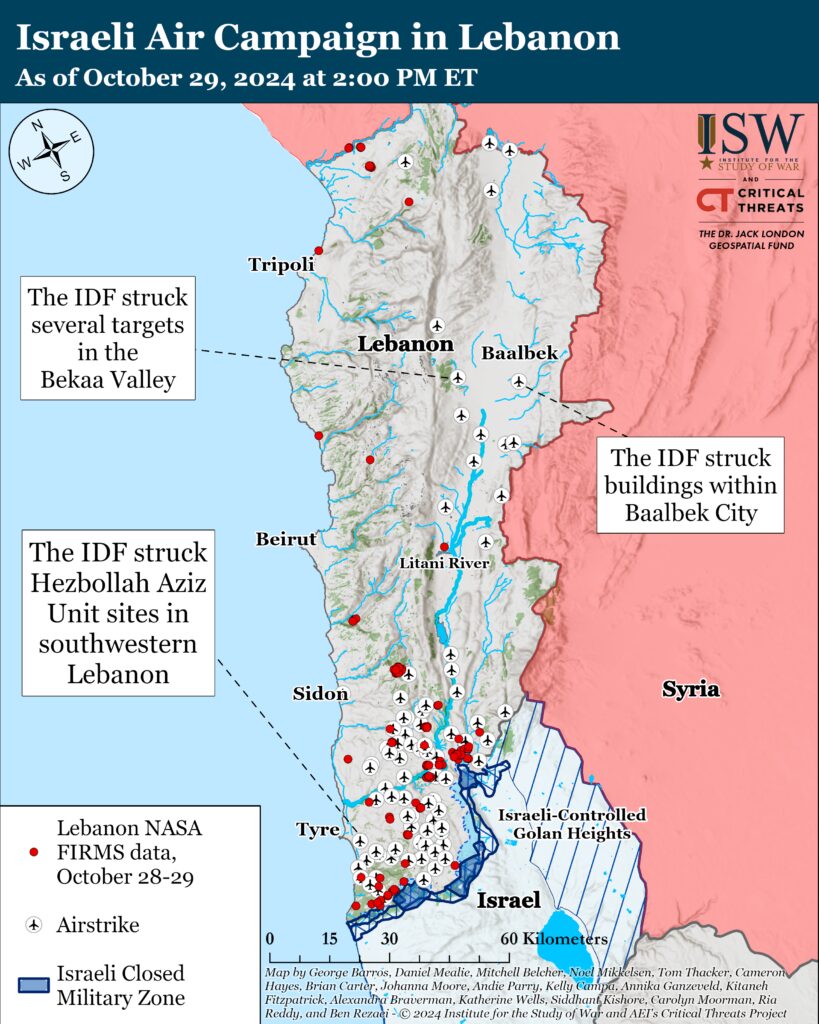
This map illustrates individual Israeli air and artillery strikes based on local Lebanese reporting. This map depicts strikes reported from 2:00pm ET on October 28 to 2:00pm ET on October 29. This map is not exhaustive. CTP-ISW cannot independently verify the locations of Israeli strikes.
Hezbollah has conducted at least 26 attacks into Israel since CTP-ISW’s last data cutoff on October 28.[142] Hezbollah fired 50 rockets targeting Maalot Tarshiha, killing one civilian.[143] Hezbollah launched one-way attack drones targeting at least seven Israeli military and civilian sites in northern Israel.[144]
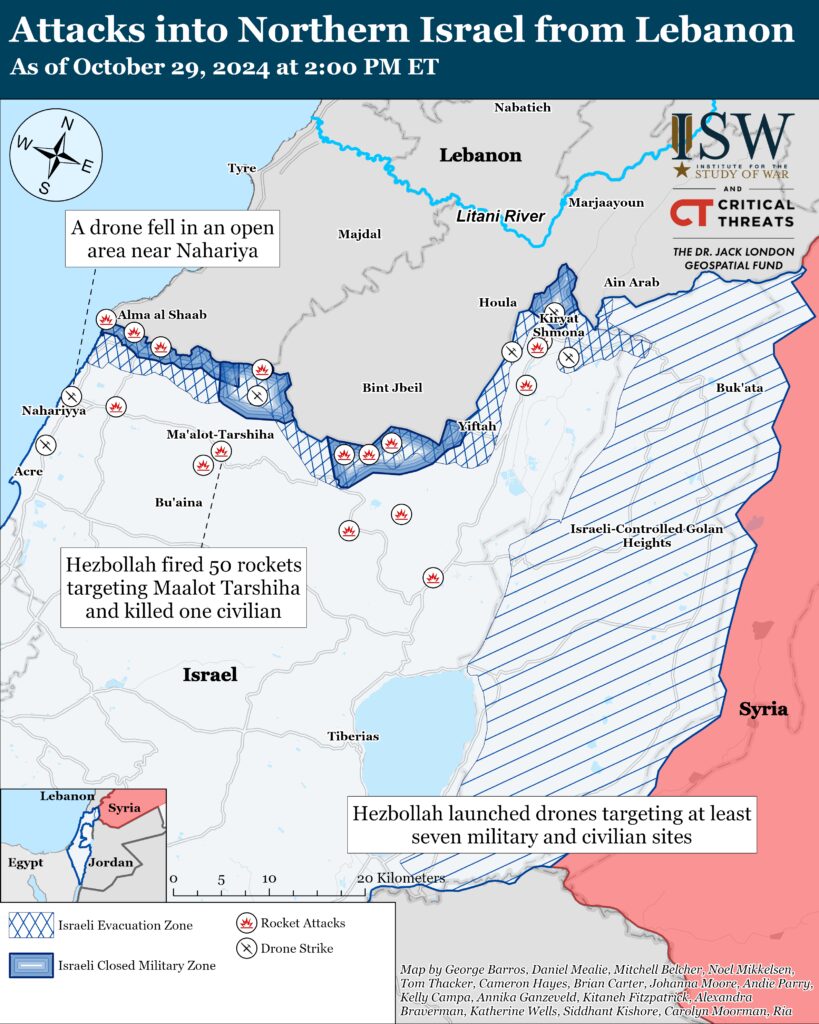
Iran and the Axis of Resistance
Funeral notices in Yemen and Iraq for Iranian-backed fighters killed in Lebanon suggest that Iranian-backed groups have embedded fighters into Hezbollah formations during fighting with the IDF. A Syrian analyst reported on October 29 that an Iraqi fighter died in southern Lebanon, thus marking the fourth known Iraqi fighter killed in action in southern Lebanon.[145] It is unclear if all four Iraqi fighters were in Iranian-backed militias, but Iranian-backed Iraqi militias have repeatedly threatened to deploy to Lebanon.[146] At least one of the four fighters was a member of Iranian-backed Iraqi militia Kataib Hezbollah.[147] The Houthis have similarly suffered losses in Lebanon, as CTP-ISW reported on October 28.[148] It is unlikely that Iranian-backed Iraqi militias or the Houthis deployed large units to southern Lebanon to support Hezbollah. Embedding small numbers of individual fighters would allow these fighters to gain experience fighting a very capable and advanced army in southern Lebanon. The Axis of Resistance could then use this small cadre of experienced fighters to leaven their forces with blooded and combat-hardened individuals.
A pro-Iranian-backed militia Iraqi member of parliament (MP) claimed that Iraq “will not hesitate” to intercept future Israeli aircraft in response to Israel’s use of Iraqi airspace to attack Iran on October 25.[149] Mukhtar al Musawi, a Shia Coordination Framework MP—a loose coalition of Iranian-backed Iraqi political parties—and former commander of a brigade in the Iranian-backed Badr Organization, said that Iraq does not have the technical capabilities to detect and intercept aircraft yet.[150] Iraq signed a deal in September 2024 to buy advanced South Korean air defense missile systems.[151]
The Pezeshkian administration proposed increasing the Iranian armed forces’ budget by 200 percent in the next Persian calendar year (March 2025-March 2026).[152] The share of Iranian Armed Forces from oil revenues rose from 136.8 trillion tomans in the current Persian calendar year (March 2024-March 2025) to 561 trillion tomans for the upcoming Persian year, reflecting a significant shift in Iran’s defense allocations.[153] The free-market exchange rate last year was 52,000 tomans per dollar, which has now increased to 68,500 tomans per dollar. The 2024-25 budget for the Armed Forces amounted to roughly 2.63 billion USD. The 2025-26 budget will increase to 8.19 billion USD for the Armed Forces, representing a 211.79% increase in dollar value.[154]
Houthi military spokesperson Yahya Sarea claimed that the Houthis launched one-way attack drones targeting Ashkelon in southern Israel on October 29.[155] The Houthis claimed that the drone attack was in response to Israeli military operations in the Gaza Strip and Lebanon.[156] The IDF reported a drone fell in an open area near Ashkelon and caused no casualties.[157]
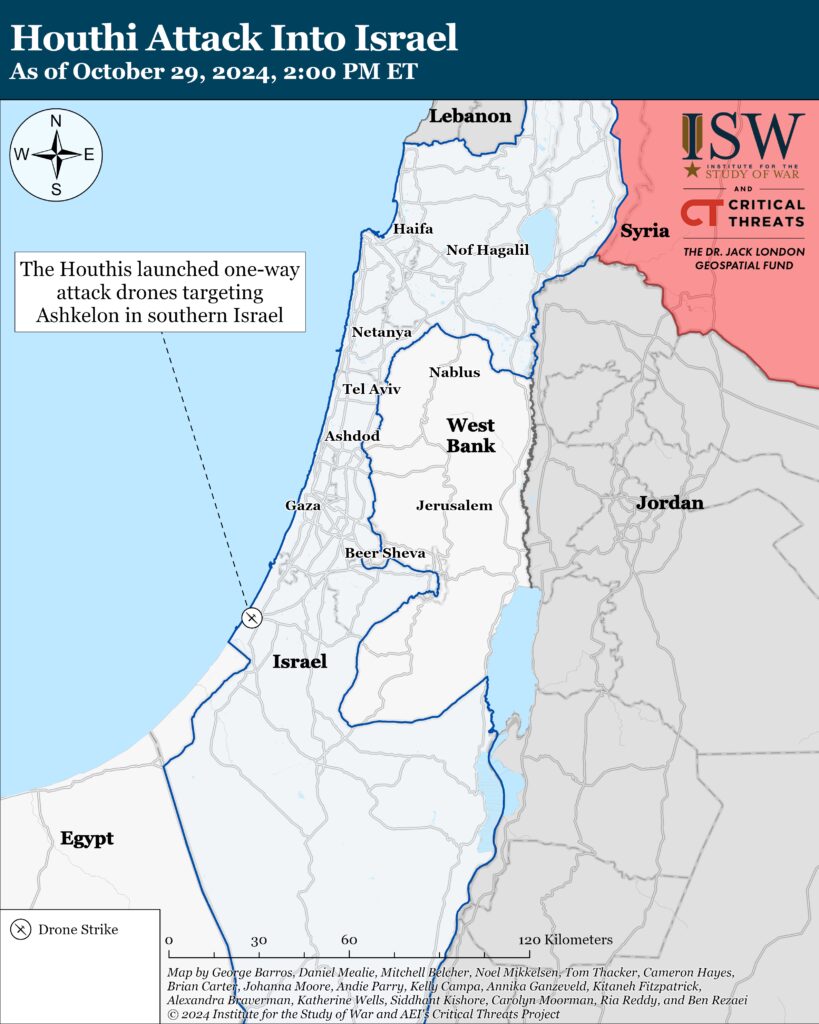
Houthi military spokesperson Yahya Sarea claimed on October 28 that the Houthis struck three Liberian-flagged container ships in the Red Sea and the Arabian Sea with drones and missiles.[158] The Houthis targeted the Liberian-flagged SC Montreal and Maersk Kowloon container ships in the Arabian Sea with drones and cruise missiles respectively.[159] The Houthis also fired several ballistic missiles targeting the Liberian-flagged Motaro container ship in the Red Sea.[160] The United Kingdom Maritime Trade Operations (UKMTO) reported three explosions near Motaro approximately 25 nautical miles south of al Mokha, Yemen, on October 28.[161] The explosions caused no damage to the ship and caused no casualties, according to UKMTO.[162] Sarea said that these attacks are part of the Houthi-imposed naval blockade of Israel that calls for a ban on vessels entering Israeli ports.[163]
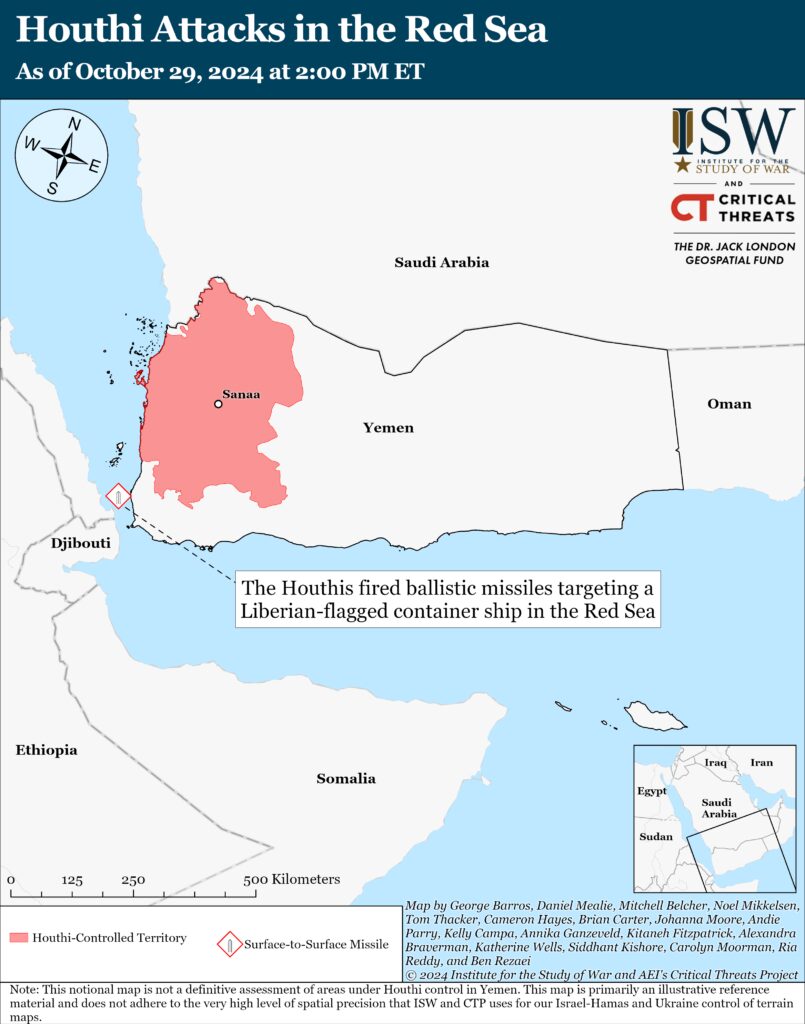
Iranian Foreign Affairs Minister Abbas Araghchi held phone calls with his counterparts in the region to discuss the importance of cooperation between Islamic countries to “stop” Israel.[164] Araghchi emphasized the importance of ”continuous contact and consultation” during his phone calls with Omani Foreign Minister Badr bin Hamad al Busaidi and Saudi Foreign Minister Faisal bin Farhan on October 27 and 28, respectively.[165] Araghchi discussed the Israeli attack on Iran on October 25 and Israeli campaigns in the Gaza Strip and Lebanon in a phone call with Syrian Foreign Minister Bassam Sabbagh on October 26.
Araghchi also held phone calls with the Egyptian and Qatari foreign ministers, possibly to discuss ceasefire efforts in the Gaza Strip. Araghchi held phone calls with Qatari Prime Minister and Foreign Minister Mohammad bin Abdulrahman al Thani and Egyptian Foreign Minister Badr Abdelatty on October 26 to discuss the Gaza Strip and Lebanon.[166] Both Qatar and Egypt have served as intermediaries between Israel and the United States and Hamas.
 Eurasia Press & News
Eurasia Press & News
